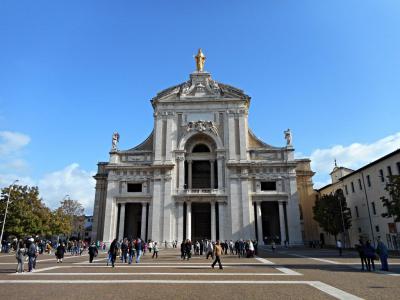
Basilica di Santa Maria degli Angeli (Papal Basilica of Saint Mary of the Angels), Assisi (must see)
Dominating the skyline of the Valley of Spoleto, the colossal domed basilica near Assisi train station is an imposing sight that can hardly be overlooked. Despite its grandeur, the structure itself lacks aesthetic appeal, having been constructed between 1569 and 1684 and later rebuilt following a devastating earthquake in 1832. Its primary purpose is to enshrine the "Porziuncola" (Little Portion), a humble hut-chapel that served as the focal point of the early Franciscan movement founded by Saint Francis.
Nestled incongruously within the church's austere Baroque interior, the Porziuncola is decorated with somewhat unfortunate 19th-century frescoes on its exterior. However, inside, visitors can view features believed to be remnants of Francis's simple stone dwelling, as well as well-preserved 14th-century frescoes depicting scenes from the saint's life. Beneath the main altar lies the excavated remnants of the old monastery, including the site where Francis breathed his last.
In the basilica's garden, pilgrims can encounter descendants of the rose bushes said to have been involved in a legendary episode from Francis's life. Legend holds that Francis, wrestling with a profound nocturnal temptation, threw himself into these rose bushes, which miraculously shed their thorns upon contact with his saintly flesh. Each May, these bushes bloom thornless, their leaves bearing the stains of the blood shed during that fateful night.
The basilica draws crowds of pilgrims on August 1st and 2nd for the Pardon of Saint Francis, during which visitors receive automatic absolution. This tradition harkens back to a vision experienced by Francis, in which Christ asked him what would best benefit the human soul. Francis replied that forgiveness should be granted to all who entered his chapel. In the 1920s, the influx of pilgrims swelled further following reports of the supposed movement of the 8-meter bronze Madonna on the facade.
Nestled incongruously within the church's austere Baroque interior, the Porziuncola is decorated with somewhat unfortunate 19th-century frescoes on its exterior. However, inside, visitors can view features believed to be remnants of Francis's simple stone dwelling, as well as well-preserved 14th-century frescoes depicting scenes from the saint's life. Beneath the main altar lies the excavated remnants of the old monastery, including the site where Francis breathed his last.
In the basilica's garden, pilgrims can encounter descendants of the rose bushes said to have been involved in a legendary episode from Francis's life. Legend holds that Francis, wrestling with a profound nocturnal temptation, threw himself into these rose bushes, which miraculously shed their thorns upon contact with his saintly flesh. Each May, these bushes bloom thornless, their leaves bearing the stains of the blood shed during that fateful night.
The basilica draws crowds of pilgrims on August 1st and 2nd for the Pardon of Saint Francis, during which visitors receive automatic absolution. This tradition harkens back to a vision experienced by Francis, in which Christ asked him what would best benefit the human soul. Francis replied that forgiveness should be granted to all who entered his chapel. In the 1920s, the influx of pilgrims swelled further following reports of the supposed movement of the 8-meter bronze Madonna on the facade.
Want to visit this sight? Check out these Self-Guided Walking Tours in Assisi. Alternatively, you can download the mobile app "GPSmyCity: Walks in 1K+ Cities" from Apple App Store or Google Play Store. The app turns your mobile device to a personal tour guide and it works offline, so no data plan is needed when traveling abroad.
Basilica di Santa Maria degli Angeli (Papal Basilica of Saint Mary of the Angels) on Map












Sight Name: Basilica di Santa Maria degli Angeli (Papal Basilica of Saint Mary of the Angels)
Sight Location: Assisi, Italy (See walking tours in Assisi)
Sight Type: Religious
Sight Location: Assisi, Italy (See walking tours in Assisi)
Sight Type: Religious
Walking Tours in Assisi, Italy
Create Your Own Walk in Assisi
Creating your own self-guided walk in Assisi is easy and fun. Choose the city attractions that you want to see and a walk route map will be created just for you. You can even set your hotel as the start point of the walk.
St. Francis' Assisi Walking Tour
A holy city for Christians, Assisi has been an eternal destination of pilgrimage since the 13th century for those venerating Saint Francis and wanting to the see where he was born, worked, died and was buried. As the birthplace of one of Catholicism’s most revered saints (and one of Italy's two saintly patrons), Assisi holds religion very close to its heart.
The entire city-sanctuary –... view more
Tour Duration: 2 Hour(s)
Travel Distance: 3.2 Km or 2 Miles
The entire city-sanctuary –... view more
Tour Duration: 2 Hour(s)
Travel Distance: 3.2 Km or 2 Miles
Assisi Introduction Walking Tour
Assisi is located on the western slope of Mount Subasio. It is 1,300 feet above sea level, overlooking the rivers Topino and Chiasicio. It is a walled city with narrow, twisting streets and alleys. It originally was known as Assisium. Successively Umbrian, Etruscan and Roman, it became a Ghibelline commune in the 11th century.
There were clashes with Guelph Perugia. In the battle of... view more
Tour Duration: 2 Hour(s)
Travel Distance: 1.9 Km or 1.2 Miles
There were clashes with Guelph Perugia. In the battle of... view more
Tour Duration: 2 Hour(s)
Travel Distance: 1.9 Km or 1.2 Miles


